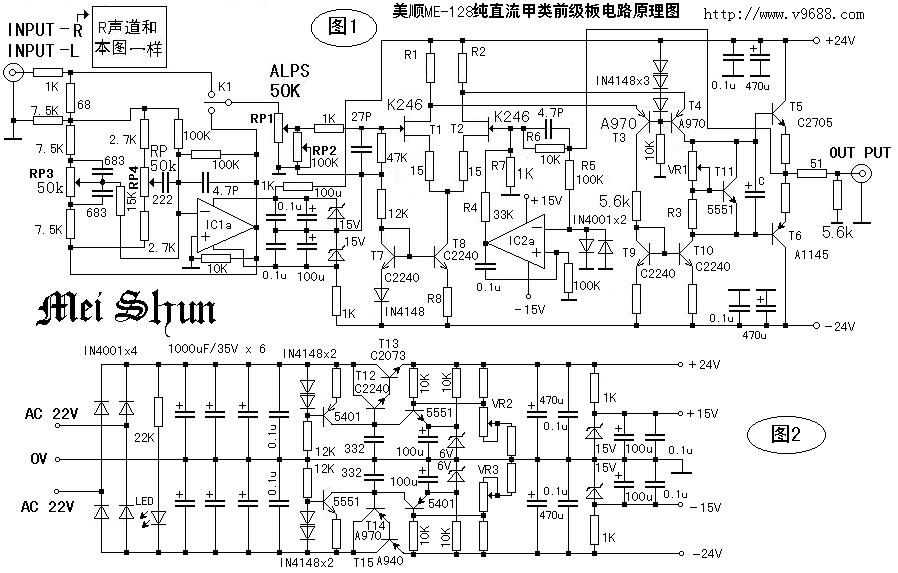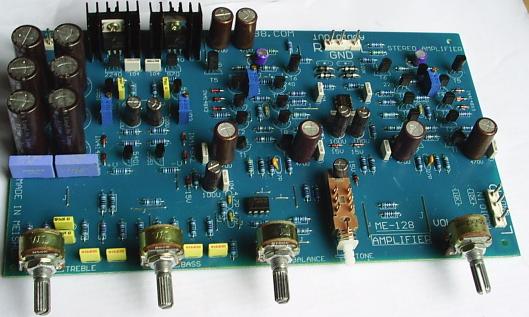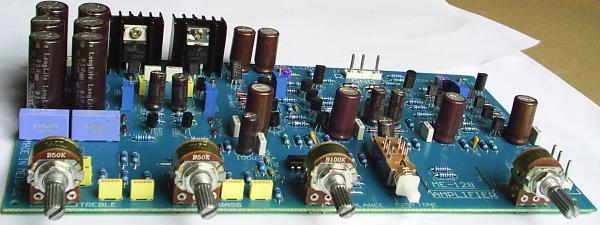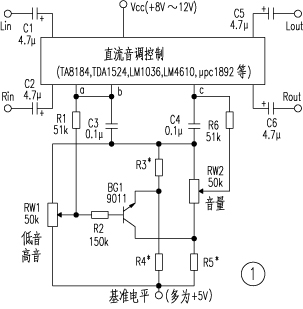Enthusiasts who pay attention to the details of music know that the pre-amplifier plays a role in the audio circuit, which has an impact on impedance matching, dynamic exhibition and presence. The use of op amps is simple and easy, but the effect is not good enough. The discrete components are relatively complicated, but the effect is good.
The author has designed the single-ended pure DC Class A preamplifier circuit as shown in the figure through multiple design and debugging sounds (and produced by Meishun Electronics Factory, Yunan County, Guangdong Province, model ME-128), and its sound is clear Delicate, open sound field, clear and accurate positioning, which is more than the author's comparison of more than a thousand yuan of front and rear levels. The comparison is the same sound source, power amplifier, and speaker, only the front level is compared (compared front level machine The author replaced the op amp with AD827), and I feel very happy by comparing the author, and my efforts are not in vain! To this end, he wrote an article for copying by DIY enthusiasts, but he refused free commercial copying.
Single-ended Class A, back to nature! The single-ended Class A line has excellent transient characteristics, pure sound quality, and rich even harmonics, which makes the sound more pleasant, and the sound is like the sound of a tube.
Following the principle of simplicity and supremacy, I designed the single-ended Class A preamplifier shown in Figure 1 (only one channel is drawn in the figure, and the other channel is the same). Its characteristics are as follows:
Fever-level design concept: the use of fever celebrity K246, A970, C2240, A1145, C2705, etc., the signal is designed to be pure Class A from the input stage to the output stage, so as to avoid crossover distortion, and the sound and hearing are particularly good Good dynamics and strong analytical power.
The input stage uses a field effect tube as a single-ended differential circuit to pursue a pleasant sound. The input stage uses a field effect tube to benefit the signal-to-noise ratio. The input impedance is high, which is conducive to the pickup of weak signals. Its transmission characteristics are similar to the electron tube. Shows a timbre-like tone.
In order to adapt to different sound sources and fever angles, a tone circuit composed of NE5532 and the like is added (if better, it can be changed to high-quality op amps such as AD827), and a direct switch is provided. When you like to listen to pure music, press the self-locking switch. K can skip the tone and enter the pure Hi-Fi state.
The power supply part is a discrete component regulated power supply designed based on the revision of the Watian regulated power supply in the reputation of the audio industry. It has extremely low output internal resistance, high voltage regulation accuracy, fast response speed, and good power supply ripple. Absorption characteristics, thus ensuring the purity of this pre-stage tone.
Brief description of the principle: IC1 and its peripheral components are tone circuits, K1 is a through / tone switch, T1 and T2 are single-ended differential circuits composed of field effect transistors, T7 and T8 are its constant current sources, R1 and R2 are T1 For the load of T2, this stage does not use a mirrored constant current source as the load to improve the conversion speed of the overall circuit and ensure fidelity. Practice has proved that the distortion of the circuit when the mirror constant current source is used as the load is greater than that when the resistor is used as the load. This is why the more concise Hi-Fi, the less distortion. I set the quiescent current of this class to be about 3mA (per tube), so that the class works in the Class A state, so there is no switching distortion and crossover distortion, and the dynamic range is improved. The single-ended Class A line itself can cancel the odd harmonics Wave distortion, and even harmonics are more abundant, play a certain moisturizing effect on the tone, beautiful listening, warm and soft tone, has better hearing resistance and is deeply loved by enthusiasts.
T1 and T2 convert the input signal into a current change, and then T3 and T4 convert the current change into a voltage output. T9 and T10 are the mirror constant current sources of T3 and T4 to ensure the stability of the stage; the voltage amplification stage uses a total of Base circuit, this circuit is mostly used in wide-band amplifier circuits, with extremely high frequency characteristics; T5, T6 are output stages, T11 and VR1, R3 are its static bias circuit, by adjusting VR1 to make the output stage static current at 10-20mA is enough. At this time, T5 and T6 work in Class A state, so as to obtain better sound fidelity and dynamic characteristics.
Figure 2 is the power supply part of the previous stage. In order to improve the filtering characteristics, both positive and negative voltages are used in parallel with three 1000uF capacitors to reduce the internal resistance of the capacitor and obtain higher-speed filtering characteristics. This regulator circuit is The discrete component voltage regulator power supply designed according to the revision of the Watian type voltage regulator power supply, the adjustment tube adopts T12, T13, T14, T15 to form a Darlington structure, which increases the response speed, and a 332 capacitor filter is added at its base To remove high-frequency clutter, VR2 and VR3 are the potentiometers for adjusting the power supply voltage. By adjusting, the positive and negative power supplies are equalized, thus obtaining the best power supply effect.
Component selection: In order to obtain the perfect effect, the author chooses all the materials for fever: ①All electrolytic capacitors use Japanese ELNA supplement high-speed electrolysis (special for advanced audiophiles, the price is more expensive, such as the 6 used in this pre-level filter 1000uF / 35V is 8 yuan each, 6 total 48 yuan); ② All electrodeless capacitors use the new Dutch Thomson MKP polypropylene non-inductive capacitors (the performance is better than those disassembled WIMA capacitors), and less than 100P Use monolithic capacitors; ③All resistances are imported 1 / 4W five-color ring precision low-noise metal film resistors; ④Fine-tuning potentiometers VR1, VR2, VR3 use precision potentiometers, and volume potentiometers use Japanese ALPS, as tone, balance The three potentiometers use Taiwan's X.T brand; ⑤The tone / through switch uses silver-plated self-locking switches, and the two operational amplifiers use NE5532; ⑥Fever audio tube: input level K246 (Toshiba low noise field effect tube) ), Constant current source and voltage amplification using Toshiba's audio-specific high-frequency low-noise famous tube A970 / C2240 (100Mz), lose Toshiba uses Toshiba's high-frequency low-noise audio tube A1145 / C2705 (200Mz), or Hitachi's B647 / D667 (140M); ⑦In order to ensure sound quality, the circuit board uses glass fiber epoxy board and silver plating process ( It can prevent oxidation and reduce the resistance of solder joints, which is helpful to improve the analytical power of small signals and ensure good sound quality and fidelity). It is printed with blue oil for high-grade; ⑧ To ensure the balance of sound quality and high fidelity, left and right All tubes of the channel should be matched (within 3% error).
Debugging: If the installation and inspection are correct, you can connect a 50W dual 22V ring cow for debugging. Do not connect the audio source first, adjust the power supply voltage to 24V, and pay attention to the positive and negative voltages to be symmetrical, so as to ensure high fidelity. Then measure whether the output has a DC voltage, if not, it is normal, and the next debugging can be carried out: â‘ The static current of each tube of the input stage is adjusted to about 3mA (helps to improve the dynamic range and make it work in the Class A state) ; â‘¡ The output tube is adjusted to 10-20mA, so that the A1145 / C2705 works in the Class A state (do not adjust it too high blindly, so as to avoid the heat seriously affecting the stability, and easy to burn the tube); â‘¢ The output level measured for more than 15 minutes after being energized. Can audition.
The audition equipment is as follows: Marantz CD machine is used as the sound source, the speakers are made by Hivi R1C + SS6N self-made bookshelf monitor speakers, and the domestic famous brand front and rear power amplifiers (the front stage has been beaten with the AD 827, the sound quality is better than the original). Zhang Tingyi ’s CD songs were relatively auditioned, and it was clearly found that the single-end pure DC Class A preamplifier in this article has a special flavor compared with the preamplifier preamplifier: the preamplifier has a wide sound field, particularly good dynamics, shows music positioning, The resolution is very good, the low frequency control is very good (retractable), the overall sense is rich, the high frequency is slender, the middle frequency is sweet and mellow, beautiful and beautiful, especially when playing a genuine Hugo CD, the singer's tooth sound, breathing The sound is clear and audible, fully reflecting the advantages of single-ended pure DC Class A circuit! The details are vivid, the treble is silky smooth, and the sound quality is very pure! Her spotless tone will definitely make you unforgettable!
Finally, remind the fake enthusiasts to note: pay attention to the design of the input ground and output ground on the circuit board must be separated to the power supply before connecting. In addition, it must be selected according to the components mentioned in the article (the overall cost is only more than 100 yuan, not too much). Only in this way can you get good results! Use this pre-level to replace and upgrade the existing audio. If you want to assemble the power amplifier, it can be equipped with a class A post-stage amplifier (for example, Meishun ME-308 pure DC current negative feedback type A amplifier, circuit schematic diagram). 



Follow WeChat

Download Audiophile APP

Follow the audiophile class
related suggestion
Some people say that there is a fog in the UK-London, so the audio equipment produced in the UK is also ...
The core part of the circuit consists of a DC tone control IC, an NPN transistor and ...

